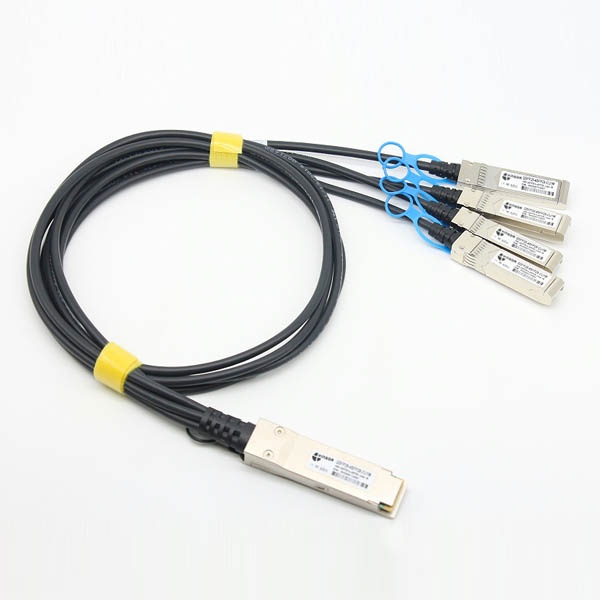AOC cable is active optical cable, DAC is direct attach cable with copper wire. Both are widely used in AI computing, real-time data processing, data centers with high bandwidth and high speed transmission like 40G/100G/200G/400G or even 800G ultra-high-speed transmission. The final package can be truck cable or breakout cable, which adapt to heterogeneous device ports. Both type of cable support mainstream interfaces like QSFP-DD, HDMI, and directly connected to servers and switches.
However, DAC direct attach cable are mostly used in short distance transmission less than 7 meters, with low cot and lower power consumption,but signal attenuation and electromagnetic interference issues need to be considered.
Below mainly introduce the advantages of the aoc active optical cable.
The physical advantages of FOC cable
AOC cables use optical fiber cables, while DAC cable use twinax copper cables. At the same length, the weight of fiber optic cables is only 1/4 of that of copper cables, and the volume is reduced by about 50%, which can reduce the load-bearing pressure of cabinets and improve space utilization. At the same time, because ofc cables are more flexible, they support compact wiring and adapt to high-density cabinet environments.
Superior transmission performance
AOC fiber optic cable transmission distance can reach 100-300 meters with multimode fiber, which can meet the needs of cross-rack and floor connection. Cable direct attach can only transmit up to 7 meters, so it is generally suitable for internal connection in cabinets.
Fiberoptic cable transmission is completely immune to electromagnetic interference, ensuring signal integrity in high electromagnetic environments in data centers.
The BER (bit error rate) of AOC active cables can reach 10-12, and its reliability is better than that of copper wires.
Lower power consumption
At the same transmission rate, SFP AOC cable power consumption is significantly lower than direct attach copper cable (e.g. 200G AOC port power consumption is about 4W), which helps data centers save energy and reduce emissions. AOC fiber cable diameter is thinner than twinax DAC cable, which can improve cabinet airflow and reduce the risk of local overheating.
Lower operation and maintenance costs
Fiber active cable integrates optical modules, plug and play, no independent optoelectronic conversion equipment is required, reducing fault nodes and making deployment more convenient.
At the same time, AOC long-distance transmission does not require relay equipment, reducing the overall total cost of ownership TCO.
Conclusion
Active optical cable assembly has become the core solution for high-bandwidth, high-density interconnection in data centers through its lightweight, high-speed, long-distance, strong anti-interference, and low-power consumption features. It is especially suitable for AI and cloud computing; DAC twinax cable remain competitive in short-distance and low-cost scenarios.
FAQ
What is the interface compatibility of AOC?
The AOC cables produced by Yingda are compatible with various brands of switches and network cards, such as Huawei, H3C, Cisco, ZTE, NVIDIA, Ruiie, Intel, IBM, D-link, Dell, TP-Link, HPe, Juniper, Aruba, Netgear, Brocade and many other brands. Please advice before buying.
What is AOC in cable?
AOC is short for active optical cable.
What is the difference between AOC and DAC cable?
AOC is active optical cable for long distance transmission like interconnection of data centers and cabinets, while DAC is direct attach cable with copper wire, which is suitable for short distance within 7meters inside of cabinets.
What is the meaning of AOC HDMI cable?
AOC HDMI cable, also known as HDMI fiber cable or active optical cable, is a type of HDMI high-definition cable that uses optical fiber as the transmission material. This cable integrates the photoelectric conversion circuit at the interface, realizing the process from electrical signal to optical signal and then from optical signal back to electrical signal, thereby achieving zero impedance and uncompressed signal transmission.
What are the disadvantages of a DAC cable?
DAC direct attach cable use copper wire, heavy weight, larger size, suitable for short distance connection instead of long distance, but susceptible to electromagnetic interference, which may increase data transmission errors, result in signal degradation, or even reconfigure / replace cables.
If compared with passive optical cable, DAC cable with more active components like hot pluggable modules, so its cost is higher with relatively high failure rate.
When to use DAC cable?
DAC Cable is often used in environments that require rapid deployment and maintenance, or where high-performance computing and storage area network (SAN) connections are required, for example: within server racks or between adjacent racks (1-7 meters) featuring low latency, high reliability and cost-effectiveness.
Which is an advantage of using DAC cables?
DAC cable are low latency and anti-interference, excellent attenuation, and high-frequency broadband transmission. Passive DAC cable don’t need power supply, so the power consumption is very low. Besides, copper cable price is relatively low, which reduce the wiring cost of the data center.
Do DAC cables get hot?
DAC cables will heat up under normal use, but the degree of heating depends on many factors: resistive heating, preference attenuation and reflection, environmental factors. We can reduce the heating by using low-resistance materials, improving heat dissipation conditions and environmental control.



